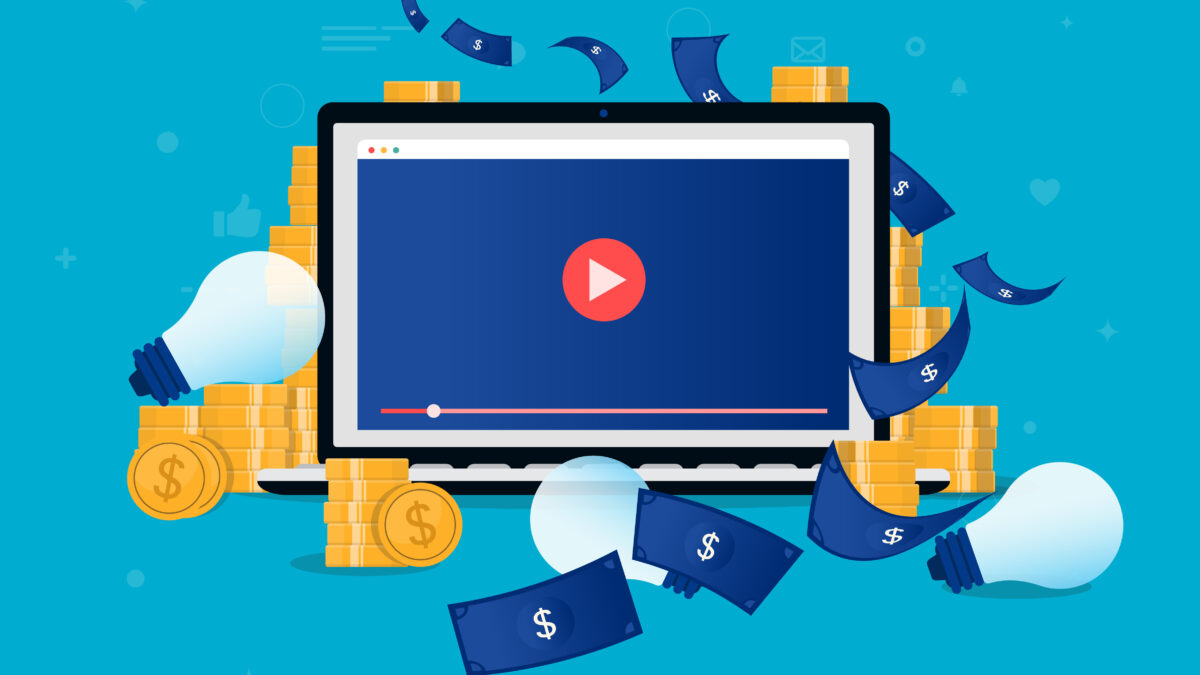Making money from your content is the end goal for creators. How do you actually do that? There are many different ways to monetize your content, some of which will be more appropriate for your content than others.
Let’s take a closer look at the main ways you can monetize your content and how to decide what makes the most sense for you as a creator.
Types of Monetization for Creators
What options do you have for earning an income from your content? Before you can narrow down what you want to do, it’s helpful to take a broad look at your options.
Here is an overview of the main types of monetization you can access as a creator:
- Ads: Having ads placed around your content through AdSense, Google Ads, Ezoic, Media.net, AdThrive, MediaVine, etc.
- Brand sponsorships: Videos, writing, social media posts, images, or other content paid for by a specific brand
- Selling products: Merch, digital products, white-labeled products, webinars, etc.
- Selling services: Consultations, completing projects, professional services, etc.
- Viewer subscriptions: Memberships, paywalled subscription content, etc.
- Affiliate marketing: Partnerships with brands that provide a small commission when your audience buys something from your recommendations (affiliate links)
- Tips/donations: One-time viewer donations via tipping platforms like Buy Me a Coffee, Paypal, and Ko-Fi, or donations via streaming platforms like Twitch or YouTube
- Online learning courses: Selling access to digital courses in your area of expertise
- Endorsements/brand deals: Collaborating with a company to create and release branded products or to endorse some of their existing products
These are just the main categories of monetization. There may be other creative ways you can find to make money from your content. More power to you!
The first rule of monetization is “don’t put all your eggs in one basket”. Start with a single income source, but plan for multiple streams of income that you can add later. If you make a good plan from the beginning, you’ll be better prepared for growth as it comes.
Whatever you’re planning, don’t jump into anything without first running your ideas through a few filters. Let’s take a look at a few filtering criteria that can help you get a solid monetization plan in place.
Knowing Your Audience

No matter what you’re creating, monetization always depends on your audience. You’re not actually monetizing the content itself as much as you’re looking to monetize the audience consuming that content. You need to make your plans with them in mind.
Look at these 3 areas specifically:
Your Niche
Every industry is different. Depending on what niche you’ve settled into, your audience may not respond to all types of monetization the same. This can be problematic in a few ways:
- You can water down your credibility in the niche
- There may not be a good enough return on your time/resource investment
- You could be spreading yourself too thin
Make sure your monetization ideas line up with the type of content you make in your niche. Stay away from monetization that’s going to drive away your core audience unless you’re planning to make a shift in the type of content you produce.
Audience Size
Some monetization methods only work if you have a larger audience. For example, you can’t get ads put on your blog until you have a certain amount of monthly traffic, usually a minimum of 1,000 views per month. You also aren’t likely to receive good sponsorship deals unless you’ve got a large enough audience to attract the attention of brands in your industry. The exact need will vary, depending on how competitive your niche is.
Audience size shouldn’t deter you from trying to monetize. There’s plenty you can do with a smaller audience, but you have to be smart about what you try. Not all options will be available to you when you have a smaller audience, but you will still have options.
Demographics
For the best chances of success, you need to match your monetization with your audience demographics. Design/recommend products they would like, offer courses that make sense for their age and experience level, or offer membership benefits they would value.
Monitor your audience analytics to get demographic insights. You can get information about the age ranges of your audience, their locations, genders, and interest categories. While you won’t be able to see specific information about individuals, this data overview allows you to make better decisions on how to monetize appropriately for your audience.
Defining Your Brand

Many small brands die off because they lose track of their core values, diluting their brand for the sake of a little extra income. There can be short-term benefits in a lot of different monetization strategies, but if they don’t line up with your brand and what you want to put out into the world, you’re ultimately making it difficult to grow and retain your audience in the long-term.
How many influencers have we seen in the past year alone who preached a specific message, only to then take on a brand deal with a company that completely goes against that message? How many YouTubers and TikTokers have we watched crash and burn after they endorsed a company that ended up screwing over their audience?
It might be difficult to turn down sponsorships or leave money on the table when an opportunity arises, but it’s better to set clear boundaries. Define your brand and stick with monetization that works in harmony with your core values.
Focusing on Your Goals

Monetization is meant to help you reach your goals as a creator. Depending on what those goals are, some ways of monetizing will be more helpful than others.
For a more passive income source, ads and affiliate marketing might be the right option. If your goal is to go from part-time to working full-time as a creator, you’ll probably need something with a higher earning potential that gives you more control over the income earned.
Settle on a monetization choice that helps you reach your goals with the resources you have. It could be a first step towards something bigger, a short-term boost to jumpstart your career, or a long-term slow burn to build up momentum. As long as you know how your monetization fits into your overarching plan, you’ll be better prepared to move forward.
Meshing with Existing Monetization
If you’re already monetizing your creations in some way, make sure any new income streams don’t clash with what you’re already doing. Try to find a way to mesh your monetization harmoniously, or else you may need to rethink what you’re doing.
A good example of this is affiliate marketing. If you’re running a website that’s earning income from Amazon affiliate links, it may be difficult for you to launch a new physical or digital product without cutting into your affiliate earnings. Your own products may compete with sales from your affiliate links.
What’s in the Market?

It’s not a good idea to copy-paste what other creators are doing, but you should always look at your competitors during your research. Whether you’re going to release a product, start a membership plan, post affiliate links, etc., you need to offer something that’s better or at LEAST as good as what’s already available in the market.
Don’t try to compete directly with big market players unless you’re able to do it better or you have a unique angle. It sounds a bit harsh, but you’re going to have a difficult time if you’re not offering your audience something truly valuable or different.
Research your industry, look for gaps, then offer something to help fill those gaps. Or, make your own branded version of something your audience already needs.
Understanding Your Abilities & Limitations

What can you handle, and how much effort are you willing to put in to make something work?
There’s a trade-off with monetization that involves the amount of effort required and the potential payoff. The simpler it is to set up and maintain your monetization, the less you’re likely to make from it in the long term. It doesn’t always happen this way, but there’s a definite correlation between the amount of effort expended and the potential profitability.
Setup
Setup involves any steps that have to happen for you to start earning. Some monetization methods have a much longer setup process, while others are nearly effortless. For example, activating ads on for your YouTube channel or blog is very simple if you meet the traffic requirements. On the other hand, launching a merch line involves a lot more time and energy designing the products, developing manufacturing partnerships, and building a storefront for your customers.
Ads, affiliate marketing, selling services, memberships, and setting up a tipping service have the simplest setup requirements. Sponsorships and anything involving brand partnerships will be a step up and will require you to have a certain size or type of audience. The most complex monetization methods to start are selling products (digital or physical) and creating courses.
Maintenance
Once you’ve gotten started, the time and resource commitments shift. Many digital and physical products don’t require a lot of maintenance to continue being sold, while online courses need continuous updates. Sponsored content doesn’t have a long lifetime, but memberships and tipping might require you to provide extra perks to your subscribers. Ads and affiliate marketing don’t take much time to maintain.
Scaling
The last thing to consider with time and effort invested is how much potential you have to scale with your chosen monetization plan. Scaling is easier when you have more control over the process, such as with selling your products and services or offering membership. Options like ads, affiliate marketing, and sponsored content can scale, but they’re more likely to scale slowly and unreliably.
How will you start earning from your content in 2023? Let us know in the comments below!


